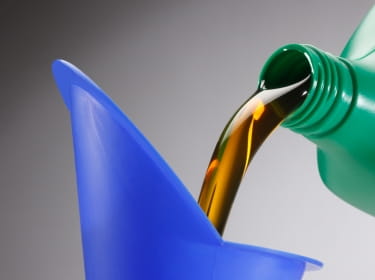Dangerous Household Hydrocarbons From Baby Oil to Kerosene

The Bottom Line
Hydrocarbons include baby oil, mineral oil, household lubricating oil, lamp oil, torch fuel, lighter fluid, gasoline, kerosene, motor oil, heating oil, hair oil, and some kinds of furniture polish. These slippery liquids easily can be breathed into someone's lungs when they try to swallow them. This can cause pneumonia and death.

The Full Story
Baby oil, mineral oil, and household lubricating oil are hydrocarbons. These slippery liquids can easily go down the wrong way, into the lungs, when someone swallows them. Other hydrocarbons include lamp oil, torch fuel, lighter fluid, gasoline, kerosene, motor oil, heating oil, hair oil, and some kinds of furniture polish.
Poison Control often receives calls about toddlers who drank baby oil or another type of hydrocarbon. Each child has to be observed very carefully for signs of aspiration, that is, hydrocarbons going down into their lungs.
Coughing, choking, and fever are common signs of hydrocarbon aspiration. Lung irritation and pneumonia, even death, can result. Symptoms can happen quickly – within a couple of hours or even sooner. If there are no symptoms in 24 hours, the child should remain fine.
Prevention is very important, because aspirating a hydrocarbon is so dangerous. Always re-close the child resistant caps. Lock oils and other hydrocarbons out of children's reach - even bottles of baby oil! Don't put these products down and turn your back, even for a second. It takes only a second for a child to grab the bottle and take a drink.
If someone swallows oil or another hydrocarbon, use the webPOISONCONTROL® online tool for guidance or call Poison Control at 1-800-222-1222. Questions you will be asked include:
- Is the person coughing, choking, or having any other symptoms?
- What is the product?
- When did this happen?
- How old is the person?
- Does he or she have other health problems?
- What is your phone number?
Then, you will be told exactly what to do. Sometimes, close observation at home will be enough. Sometimes, emergency room care will be needed.
Take-Home Messages:
- Hydrocarbons include baby oil, mineral oil, household lubricating oil, lamp oil, torch fuel, lighter fluid, gasoline, kerosene, motor oil, heating oil, hair oil, and some kinds of furniture polish.
- These are slippery liquids that easily can be aspirated (breathed into someone's lungs when they try to swallow them).
- Hydrocarbon aspiration can cause pneumonia and death. Symptoms occur quickly.
Rose Ann Gould Soloway, RN, BSN, MSEd, DABAT emerita
Clinical Toxicologist
Poisoned?
Call 1-800-222-1222 or
Prevention Tips
Prevention is very important, because aspirating a hydrocarbon is so dangerous.
- Always re-close the child resistant caps.
- Lock oils and other hydrocarbons out of children's reach – even bottles of baby oil!
- Don't put these products down and turn your back, even for a second. It takes only a second for a child to grab the bottle and take a drink.
This Really Happened
A 6-year-old boy with a history of developmental delay and seizure disorder had a chest x-ray during a routine medical examination. The x-ray showed an infiltrate (a collection of fluid or cells in the airspaces of the lung) in his right lung. He was treated with antibiotics but the infiltrate was still there 2 months later.
Further evaluation revealed that he had chronic constipation and was given mineral oil by mouth every day. Also, he had occasional coughing and choking while being fed. The mineral oil was discontinued.
A pulmonary work-up didn't uncover any medical reason for the lung infiltrate. A bronchoscopy (a viewing tube evaluates the airways) was normal except for redness in a bronchial tube of the right lung. Fluid obtained from this area was milky white with fat globules floating on the surface. This fluid was compared with a sample of the mineral oil that the child had been receiving; testing showed a 99.99% likelihood that the lung fluid sample matched the patient's mineral oil.
Three months after the bronchoscopy the child was in his usual state of health without any respiratory symptoms, though the infiltrate remained on his chest x-ray.
References
Jolliff HA, Fletcher E, Roberts KJ, Baker SD, McKenzie LB. Pediatric hydrocarbon-related injuries in the United States: 2000-2009. Pediatrics. 2013;131:1139–1147.Poisoned?
Call 1-800-222-1222 or
Prevention Tips
Prevention is very important, because aspirating a hydrocarbon is so dangerous.
- Always re-close the child resistant caps.
- Lock oils and other hydrocarbons out of children's reach – even bottles of baby oil!
- Don't put these products down and turn your back, even for a second. It takes only a second for a child to grab the bottle and take a drink.
This Really Happened
A 6-year-old boy with a history of developmental delay and seizure disorder had a chest x-ray during a routine medical examination. The x-ray showed an infiltrate (a collection of fluid or cells in the airspaces of the lung) in his right lung. He was treated with antibiotics but the infiltrate was still there 2 months later.
Further evaluation revealed that he had chronic constipation and was given mineral oil by mouth every day. Also, he had occasional coughing and choking while being fed. The mineral oil was discontinued.
A pulmonary work-up didn't uncover any medical reason for the lung infiltrate. A bronchoscopy (a viewing tube evaluates the airways) was normal except for redness in a bronchial tube of the right lung. Fluid obtained from this area was milky white with fat globules floating on the surface. This fluid was compared with a sample of the mineral oil that the child had been receiving; testing showed a 99.99% likelihood that the lung fluid sample matched the patient's mineral oil.
Three months after the bronchoscopy the child was in his usual state of health without any respiratory symptoms, though the infiltrate remained on his chest x-ray.
